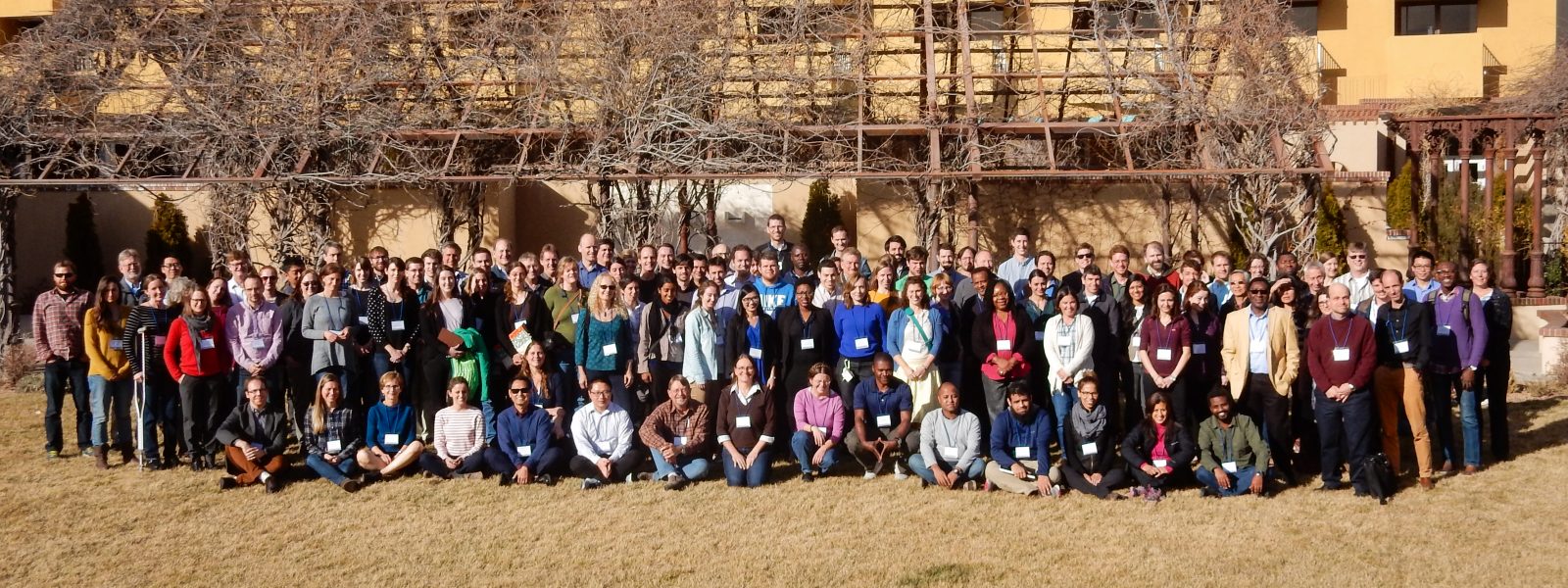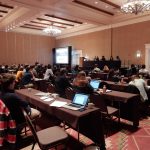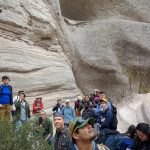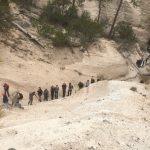Tobias Fischer1, Donna Shillington2
1University of New Mexico, 2LDEO, Columbia University
The GeoPRISMS Theoretical and Experimental Institute (TEI) for the Rift Initiation and Evolution (RIE) initiative was held February 8-10, 2017 in Albuquerque, NM. This meeting brought together 132 scientists with diverse expertise working on rifts and rifted margins around the world to discuss recent scientific advances, emerging questions, and to identify potential high-priority science for future GeoPRISMS RIE efforts. The meeting included a series of oral and poster presentations, pop ups and discussions. The workshop conveners have prepared a report that summarizes science results and future directions discussed at the workshop.
The GeoPRISMS Rift Initiation and Evolution (RIE) Theoretical and Experiment Institute (TEI) was held in Albuquerque, NM from February 7-10. The objectives of the meeting were to summarize progress and recent scientific advances related to the RIE initiative, identify high-priority science for future GeoPRISMS RIE efforts and promote community building and formation of new collaborations.
To meet those objectives, a diverse group of scientists was enlisted to serve on the convening team, give invited and contributed talks and to contribute to the meeting as attendees. The expertise of conveners, speakers and attendees spanned a broad range of interests connected with the RIE initiative, from deep geodynamical processes underlying rifting to surface processes controlling syn- and post-rift evolution. Scientists undertaking studies in the RIE primary sites (the East Africa Rift and the Eastern North American Margin) and working at other rifts and rifted margins were encouraged to contribute to all aspects of the workshop to ensure diverse perspectives. The meeting was attended by 133 participants, 59 of which were students and postdoctoral researchers. Besides attracting a large group of early career scientists, attendees included mid-career investigators who were relatively new to RIE science. Scientists from abroad were invited to attend to provide insights regarding the RIE primary sites and on rifts in general.
The meeting structure was designed to cover the broad spectrum of science included in the GeoPRISMS RIE science plan, to encourage interdisciplinarity and to bring in diverse perspectives. The main meeting had seven main oral sessions:
- Rift evolution from initiation to post rift architecture
- Geodynamics of rift and post-rift processes
- Magmatism and volatile exchanges
- Faulting and strain
- Surface processes & feedbacks between deep/surface processes
- Hazards associated with rifting environments
There was substantial time allocated for discussion and interaction; the meeting included several poster sessions at various times of day, two breakout sessions, one small-group discussion and plenary discussion after each oral session and throughout the meeting. As described in more detail below, the speakers successfully synthesized the state of knowledge on various aspects of rift evolution and of highlighting important outstanding questions. The breakouts and discussion were dynamic, generating excellent ideas and insights. The main meeting was preceded by a half-day student and postdoc symposium organized and led by three postdocs.
Overview of science presented at the meeting
Student-Postdoc Symposium
The student-postdoc symposium was held the afternoon before the main meeting and was led by Yelebe Birhanu (Bristol), James Muirhead (Syracuse), and Jean-Arthur Olive (LDEO). The organizers began the symposium with a presentation that provided an overview of the outstanding science questions related to RIE. These questions focused on the topics of rift initiation, the 4-D rift architecture, long- and short-term rift deformation mechanisms, rift volcanism, magmatism and volatile fluxes as well as surface processes at rifts and rifted margins. These topics were the focus of small group discussions later in the afternoon, and the discussion leaders summarized these discussions during the first day of the main meeting to all attendees. The symposium also included pop-ups by all participants on their RIE related research. Over sixty people attended the student-postdoc symposium, including nearly all students and postdocs at the meeting and a few representatives from the GeoPRISMS Office and GSOC, NSF and the convening team of the main meeting. The scientific discussions were followed by a career development panel discussion where students and postdocs had the opportunity to engage directly with scientists at a variety of stages in their careers.
Main meeting
The main part of the meeting began with a session on rift evolution from initiation to post-rift architecture. Roger Buck (LDEO) emphasized the role of magma throughout the life of rifts, from diking during rift initiation to the association of rifted margins with large magmatic outpourings and seaward dipping reflectors. Harm Van Avendonk (UTIG) reviewed insights on rifting processes from studies of both magma-poor and magmatic rifted margins, where recent studies show interesting variations in the distribution and timing of magmatism in relation with rifting, including provocative clues from ENAM on distribution of magmatism and highly thinned continental crust. Danny Brothers (USGS) focused on postrift evolution of rifted margins, including how sediment delivery and pre-failure configuration control evolution and evidence for active fluid venting, slope failure, and sediment compaction.
Session 2 focused on geodynamics. Jolante Van Wijk (NM Tech) provided an overview of numerical modeling approaches and the importance of testing and comparing models to both observations and other numerical solutions. Zach Eilon (Brown) synthesized geophysical observations from the Woodlark Rift in Papua New Guinea and showed evidence of limited melt, lithospheric removal and opening direction parallel anisotropy. Andrew Smythe (Penn State) showed how high-temperature thermochronology and diffusion speedometers can be used to assess mantle upwelling rates and how strain is vertically distributed during rifting. Robert Harris (Oregon State) showed high-resolution heat flow results from the Gulf of California and emphasized the role of fluid flow as well as conductive heat transfer. Colton Lynner (Arizona) showed new shear-wave splitting results from the ENAM community seismic experiment and suggests that 3-D edge driven flow at the edge of the margin can explain their observations.
Session 3 followed with talks on magmatism, volcanism and volatile exchanges. Cornelia Class (LDEO) gave an overview of the geochemical and petrological tools to identify magma and volatile sources in rift settings, highlighting the importance of using multiple geochemical systems to identify mantle components. Sara Mana (Salem State) showed chronological and geochemical data from the North Tanzania Convergence zone and highlighted the evidence for pulsed magmatism and a metasomatized mantle source. Juliane Hübert (Edinburgh) provided new insights on magma storage and pathways using magnetotelluric data in the Main Ethiopian Rift. Madison Meyers (U. of Oregon) emphasized the occurrence of large silicic volcanic centers in rift settings and showed how detailed work on volatiles recorded by melt inclusions allow for the quantification of magma ascent rates. Philip Kyle (NM Tech) ended the session with an overview of the magmatic history of the West Antarctic Rift.
Day 2 started off with the session on faulting and strain, where Cindy Ebinger (Tulane) provided a ‘recipe for rifting’ for cratonic and orogenic rifts where the difference in both crustal and mantle rheology are of critical importance for rift architecture and extension, including the possibly important but poorly known hydration state and distribution of volatiles at depth. Paul Umhoefer (Northern Arizona U.) showed how variations in inherited structures, strain partitioning, angle of obliquity and sediment input control extension in the Gulf of California – Salton trough plate boundary.
James Muirhead (Syracuse) showed the results from an interdisciplinary study in the East African Rift that better constrain the role and sources of fluids and mantle melting in the early stages of rifting and their connection to faulting. Hannah Mark (WHOI) provided new insights from modeling of observed seismic coupling coefficients that show how the thermal regime scales with seismic coupling in MOR and continental rifts. Elifuraha Saria (Ardhi) ended the session by providing an overview of geodetic constraints on crustal deformation in Africa emphasizing the fact that large parts of the continent are not adequately monitored geodetically.
Session 5 focused on surface processes and feedbacks in rifts, where Kyle Straub (Tulane) showed how geomorphology signals are stored in the stratigraphic and landscape record. His talk was followed by Jean-Arthur Olive (LDEO) who discussed the role of surface processes in the stabilization of half-graben structures. Erin DiMaggio (Penn State) talked about the connection between rift development as preserved in the stratigraphic record and the development of the Ledi-Geraru paleontological site. Liang Han (Virginia Tech) showed how rapid sedimentation in the Salton Trough resulted in the formation of new crust, delayed continental breakup and seafloor spreading, and how metamorphism of sediment can further delay final crustal breakup. Rob Gawthorpe (Colorado School of Mines) ended the session with insights on the evolution of the Corinth Rift, Greece from the onshore-offshore observations.
The final science session highlighted hazards in rifts and rifted margins. Karen Fontijn (Oxford) focused mainly on volcanic hazards in the East African Rift, emphasizing the low viscosity of rift magmas, the high potential for phreatic eruptions, and the abundance of large caldera systems as well as the role of hazardous CO2 degassing. Atalay Ayele (Addis Ababa U.) highlighted the challenges in disaster risk management in Africa that are due to limited capacity in equipment and human resources and the general level of understanding of potential risk. He also pointed to recent successes such as capacity building efforts, advances in real-time data flows, and national workshops. Maurice Lamontagne (GSC) showed how earthquakes and tsunamis related to rifting are the main hazards in Eastern Canada and how detailed mapping of ancient fault structures provides key insights on earthquake mechanisms and distributions in the region. Sang Mook Lee (SNU) highlighted the geohazards of the East Sea and the Sea of Japan and their potential to affect nuclear power plant safety.
Collaborative opportunities were discussed with presentations on the RiftVolc initiative, connections between rifting and hydrology, EarthScope and Africa Array updates.
Science themes with opportunities for near-term future studies
The TEI was designed to provide ample opportunities for participants to ask questions and discuss scientific issues related to the presentations. This was achieved through a panel discussion following each session including all speakers. Additional focused discussions occurred during two breakout sessions and small group discussions, which focused on the identification of high priority science questions and work needed to tackle these questions.
The following major science themes emerged from discussions at the TEI. For each of these themes, discussions focused on exciting recent findings and opportunities for near-term research progress through the GeoPRISMS RIE TEI initiative.
1. Tracking fluids (volatiles and magmas) through the lithosphere and with time
The importance of fluids for a spectrum of interconnected processes throughout the life of rifts and rifted margins was a topic of significant interest at the meeting. Meeting presentations covered recent results that have revealed strong, nonlinear interactions between volatiles and faults (e.g., talk by Muirhead), the important influence of prerift and synrift metasomatic events on magmatism (e.g., talk by Sana), and the capacity of fluids to advect heat and strongly modulate the thermal structure of rifts (e.g., talk by Harris). Geochemical tracers can be used to constrain the modification of the lithosphere by magmatic events (e.g., talk by Class). New studies of rifted margins also reveal unexpected mantle structure and magmatism, hinting at active processes long after rifting (e.g., talk by Lynner).
These new science results point to several exciting near-term future science directions:
- Understanding the connections between deep volatiles and shallow observations, including constraining magma and volatiles residence times and pathways
- Developing a quantitative understanding of the impact of volatiles/magmatism on strain localization and rheology (connects to theme 2)
- Connecting general rheological models to morphological and process-based differences between magma-poor and magma-rich regions
- Investigating the origin and significance of post-rift magmatism on rifted margins
2. Controls on deformation and localization at different temporal scales
Elucidating controls on deformation and localization are central to understanding rift processes, and were another major focus of meeting presentations and discussions. Magma is clearly a great localizer of strain (e.g., talks by Buck, Ebinger), but magma is not present everywhere, at least not in abundance. In magma-poor locations, fluids, pre-existing structures and/or chemical heterogeneity may be important factors (e.g., talks by Van Avendonk, Eilon). Volatiles appear to influence crustal rheology and fault behavior (e.g., talks by Muirhead, Ebinger), but are still poorly understood. The role of pre-existing lithospheric structure in strain localization appears to vary among rift systems and at different scale lengths (e.g., talks by Lynner, Eilon).
New numerical models and observations suggest that surface processes may also control strain localization (e.g., talks by Olive, Han; connects to theme 3). The slip behavior of rift faults (creeping, locked, etc.) is poorly known (e.g., talk by Mark), and there are few constraints on how it might change over time or with rift evolution (e.g., talk by Van Avendonk).
These new science results point to several exciting near-term future science directions:
- Integration of rifting processes across a range of time scales from the earthquake cycle to geologic time
- Characterization of slip behavior of faults over time and space
- Understanding variations in temporal/spatial patterns of deformation between magmatic and magma-poor systems
- Comparing transient behavior in rifts (creep, slow slip) to subduction and transform zones
- Observing how volatiles are distributed through lithosphere (connects to theme 1) with an emphasis on how they impact rheology, faulting, and transient deformation
- Constraining mantle rheology on a variety of time scales and as a function of volatile abundance, metasomatism and melt extraction processes (connects to theme 1).
3. Surface mass sedimentary fluxes and feedbacks with rifting
Recent studies have demonstrated strong connections between surface processes and all stages of rift evolution. These include the formation of new crust through rapid sedimentation (e.g., talk by Han), the impact of erosion on fault evolution (e.g., talk by Olive), the structural control of sediment pathways during and long after rifting (e.g., talk by Gawthorpe), and the structural control of slope failure (e.g., talks by Brothers and Lamontagne). The vertical displacements and crustal architecture associated with extensional tectonics strongly influence the spatial and temporal distribution of depositional domains (e.g., talks by Straub, Brothers).
These results point towards several important near-term future science directions:
- Developing more comprehensive sedimentary histories of rifts to improve understanding of rift-related mass transport
- Improving conceptual and numerical models of sediment influence on extensional processes, including thermal and mechanical feedbacks (connects to theme 2)
- Utilizing the extant and paleolake systems for integrated investigations of landscape evolution.
Efforts needed to make progress on themes within GeoPRISMS
To address outstanding questions related to the themes above, the following future efforts were highlighted as particularly important.
Synthesis
Comparing among and within rifts is important to address many of the overarching RIE science questions and the specific questions within the themes above. A growing volume of data is now available in both primary sites and in other rift systems on everything from surface processes to magmatism and deep geodynamics. These observations include existing geophysical datasets on both EAR and ENAM from GeoPRISMS and other efforts, growing geochemical data and drilling data in various rifts. Particular themes discussed for syntheses were:
- Geochemical variations along/across ENAM/EAR
- Sediment mass fluxes from existing (limited) drilling data
- Geochronological data on magmatic/volcanic events and surface processes
- Crustal/lithospheric structure of rifts from existing geophysical imaging, with focus on comparisons between and within systems with variable magmatism
- Geochemical data from geothermal exploration projects (drilling) in volcanic and non-volcanic settings.
New data collection and experimental/numerical work
From discussion at the meeting, it is clear that new data and experiments are required to tackle many important science themes, and several key gaps emerged from discussions at the meeting. Below are examples:
- Studies of volatile systems to understand their distribution/abundance/residence time at various levels in the lithosphere. This would involve integrated geophysical imaging including but not limited to MT, seismic, and detailed geochemical studies such as melt inclusions, sampling volatiles at the surface, high density flux measurements, and other approaches.
- Experimental and numerical modeling directed at the impact of volatiles and lower crust/mantle lithosphere hydration state/compositions on deformation throughout the lithosphere,
- Observations to constrain the time scales of processes are needed. These include but are not limited to more geodetic observations to understand average rates and observe transient events as well as investigations of paleoseismology, deformed volcanic ash markers, and tectonic geomorphology to understand longer term accommodation of strain by events. On a longer time scale, better and improved geologic timing information is needed.
- New constraints on sedimentary fluxes in rifts including but not limited to cosmogenic dating techniques, river incision rates, and obtaining data from new drill cores.
- Advance the understanding of landscape evolution through better access to high resolution topographic data. ■
GeoPRISMS Newsletter, Issue No. 38, Spring 2017. Retrieved from http://geoprisms.nineplanetsllc.com







